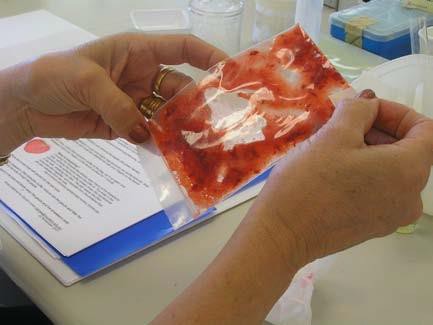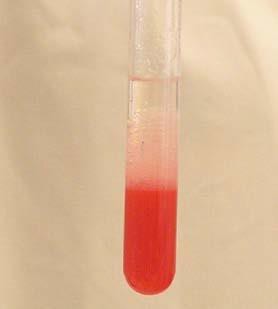DNA Extraction from Strawberries
Learning Objectives
After completing the lab, the student will be able to:
- Extract DNA from the cells of strawberry fruit tissue.
Introduction
There are four major classes of biological macromolecules: carbohydrates, nucleic acids, proteins, and lipids. Nucleic acids are found inside the nuclei of eukaryotes, including plants. They are complexed with proteins, to form chromosomes.
The first step in working with nucleic acids (DNA and RNA) is to remove the molecules from inside the cell. Different types of cells need to be processed differently in order to release nucleic acids. All cells have a cell membrane, a phospholipid bilayer that separates the internal environment of the cell from the external environment. In eukaryotes, DNA is housed inside the nucleus of the cell which is surrounded by the nuclear membrane, a second double-layered membrane, also composed largely of lipid molecules. When extracting DNA from plant cells, the cell wall must also be considered; some types of plant tissue require grinding or flash-freezing in order to break through the tough cell wall.
Strawberry fruit tissue is an excellent type of tissue to use for demonstration of DNA extraction. First, ripe strawberries are soft and juicy; as the fruit matures, the cells fill up with water and sugar, which make the fruit so delicious! Second, as the strawberry ripens, a series of chemical reactions take place within the cells that lead to the breakdown of long-chain polysaccharides, like cellulose and pectin, that make the cell wall tough. Lastly, cultivated strawberries (Fragaria x ananassa) are the product of a hybridization between multiple strawberry species, and they have an octoploid genome, meaning they have eight sets of chromosomes inside their cells, totalling 56 chromosomes. That translates to lots of molecules of DNA, which increases our yield and makes the DNA easier to visualize
This protocol for extraction of DNA is based largely on the principle of solubility. Solubility refers to the ability of one substance (the solute) to dissolve in another substance (the solvent). Recall that polar substances dissolve easily in polar solvents, but do not dissolve easily in nonpolar solvents, a phenomenon commonly referred to as “like dissolves like.” Water is a polar solvent, and molecules that dissolve easily in water are referred to as hydrophilic. DNA molecules are hydrophilic because the sugar- phosphate backbone of the molecules are highly polar. This means that DNA dissolves in water, so in this experiment, the DNA that is released when the cells are crushed dissolves in the juice/extraction buffer mixture.
Remember, there are two key ingredients in the DNA extraction buffer aside from the water: dish soap and salt. The dish soap acts to break up the lipid molecules that form the cell membrane and the nuclear membrane, which lyses the cell and releases the cellular contents, including DNA. The salt has two functions in the extraction process. It helps to neutralize the charge on the sugar-phosphate backbone, making DNA less soluble in water, and it also makes the DNA molecules stick to each other, so they are easier to visualize and remove from the solution.
Although the chemical reactions described above are all happening when you add the buffer and crush the strawberries, they are not visible with the naked eye. However, the addition of the cold ethanol caused a much more dramatic result! Ethanol is a nonpolar solvent, and when it is added to the solution of strawberry juice and extraction buffer, the DNA precipitates out of the solution. A precipitation reaction is a chemical reaction that causes a solid substance to emerge from a liquid solution. In this experiment, the addition of ethanol to the reaction forces DNA to precipitate out of solution, which we can then spool onto a stirring spoon.


Illustrations of ploidy levels; N=number of chromosomes in one set.Strawberries (Fragaria x ananassa) are octoploid (8N); illustration from Wikimedia Commons
Safety Precautions
Materials
- Plastic zipper bag
- 1 fresh strawberry
- 10 mL DNA extraction buffer
- Gauze squares 4″ x 4″ or larger
- Stirrer or spoon (to squeeze juice from berry pulp)
- Funnel
- Ice cold ethyl alcohol
- Plastic transfer pipettes
- Clear glass test tube
- Stirrer
To make DNA extraction buffer, combine the following:
- 45 mL Distilled water
- 5mL liquid dish soap
- 0.75 g NaCl (table salt)
For this activity, you will work in pairs.
Procedure
Step 1: Place strawberry into plastic zipper bag and add 10mL of DNA extraction buffer. Seal the bag tightly.
Step 2: Gently, but thoroughly crush the strawberry inside the bag for about one minute.

Step 3: Line the funnel with a gauze square. Place the funnel into the test tube.
Step 4: Pour the strawberry juice/DNA extraction buffer mixture into the funnel so the juice passes through the gauze and into the test tube. Use the gauze to strain the strawberry mixture so that only the juice flows in to the tube and the pulp is retained in the gauze. Squish the strawberry pulp as needed to obtain sufficient juice.

Step 5: Discard the gauze and the strawberry pulp.
Step 6: Layer an approximately equal volume of ice cold ethanol on top of the strawberry juice mixture in the test tube using the plastic transfer pipette.

Step 7: Hold the tube still at eye level (DO NOT shake) and observe what happens at the interface of the alcohol and the strawberry juice when you twirl your stirrer through the interface of the solutions.
Step 8: Use your stirrer to transfer your strawberry DNA into a another test tube. Add a small amount of ethanol to the tube to prevent your DNA from drying out.
Discussion
Draw in your lab book what your final product looks like (show the test tube, stirrer, DNA). How would you describe the texture and appearance of the DNA, including its color?
References:Jones, Carolyn. DNA Extraction from Strawberries. https://www.murdoch.edu.au/Biotech-out-of- the-box/_document/Kit-Handout-Sheets/DNA-extraction-from-strawberries.pdfOpenStax CNX. 2018. https://cnx.org/contents/k6E8Y6SA@8/Primary-DNA-Molecular-Structure University of Missouri, Division of Plant Sciences. 2018. Strawberry: A Brief History. https://ipm.missouri.edu/meg/2012/5/Strawberry-A-Brief-History/

